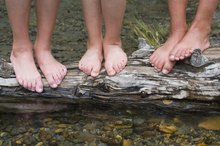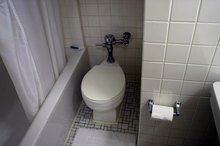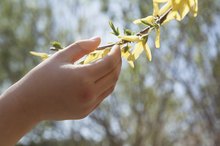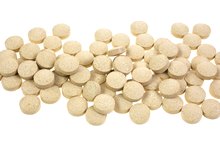Calcium Deposits in Children
Calcium deposits, also known as calcinosis, are hardened deposits of calcium that are lodged in fatty tissue or muscles. According to the Myositis Foundation, calcium deposits affect 30 percent of children who have juvenile dermatomyositis (JDM), a rare condition characterized by muscle weakness and rashes. It is rare for children in the general population to develop calcium deposits.
Presentation
Calcium deposits appear in many sizes--they can be the size of a penny, the size of a large piece of fruit and anything in between. While large deposits may be visible to the naked idea, smaller ones in the fatty tissue might only be identified by medical equipment. The deposits are hard and lumpy and may be tender or painful to touch. Deposits can change shape and size over time. Calcium deposits can be present on the fingers and toes, making it difficult for children to walk and or touch things.
- Calcium deposits appear in many sizes--they can be the size of a penny, the size of a large piece of fruit and anything in between.
- Calcium deposits can be present on the fingers and toes, making it difficult for children to walk and or touch things.
Identification
Flat Feet in Teenagers
Learn More
Children with JMD or who have lumpy deposits in muscles should seek medical attention. X-rays can identify large calcium deposits, while computed tomography (CAT scans) reveals deeper and or smaller deposits.
Causes and Effects
The cause of calcium deposits in children, specifically those with JMD, is unknown. Children with calcium deposits may experience limited range of motion of their muscles and pain around the deposits. The deposits further the weakness that children experience because of JMD. Lack of or insufficient treatment of calcium deposits may contribute to draining of the calcium deposits, placing children at risk for internal infection. If a calcium deposit opens, the area should be immediately cleaned with soap and water followed by medical attention. Antibiotics may be necessary for children with a ruptured deposit. If the skin around the deposit is red, regardless of whether the deposit has drained, the calcium deposit might be infected and children should go to the doctor.
- The cause of calcium deposits in children, specifically those with JMD, is unknown.
- If the skin around the deposit is red, regardless of whether the deposit has drained, the calcium deposit might be infected and children should go to the doctor.
Treatment
Finger Pain in Children
Learn More
Early prognosis and treatment of calcium deposits is essential; the longer a child has a calcium deposit, the more difficult it becomes to treat the condition. No medical studies have evaluated the effectiveness of medical treatment of calcium deposits, and there is no approved cure. Doctors have reported successful treatment with bisphosphonates, a drug used to treat osteoporosis. Diltiazem is a calcium-blocking drug that is used by some doctors to treat calcium deposits, but it may produce adverse side effects. Children with calcium deposits may benefit from physical therapy and range-of-motion exercises for weak and sore muscles.
- Early prognosis and treatment of calcium deposits is essential; the longer a child has a calcium deposit, the more difficult it becomes to treat the condition.
- Diltiazem is a calcium-blocking drug that is used by some doctors to treat calcium deposits, but it may produce adverse side effects.
Pain Relief
Padding or bandages can be placed on fingers and toes to prevent pain while walking or touching objects. Warm baths or heating pads may help reduce pain and swelling around the deposit.
Related Articles
References
- Le C, Bedocs PM. Calcinosis cutis. In: StatPearls. Updated September 5, 2019.
- Reiter N, El-shabrawi L, Leinweber B, Berghold A, Aberer E. Calcinosis cutis: part I. Diagnostic pathway. J Am Acad Dermatol. 2011;65(1):1-12. doi:10.1016/j.jaad.2010.08.038
- Sahu SK, Gupta N, Vohra S. Calcinosis cutis secondary to facial acne vulgaris: A rare complication. Indian Dermatol Online J. 2015;6(Suppl 1):S37–S39. doi:10.4103/2229-5178.171040
Resources
Writer Bio
Judy Bruen is a private certified personal trainer and wellness coach. She holds dual master's degrees from Boston College in clinical social work and pastoral ministry. She currently works with individuals on fitness, health and lifestyle goals.









